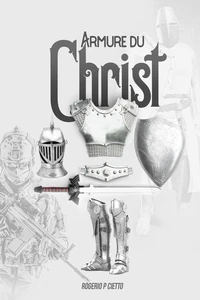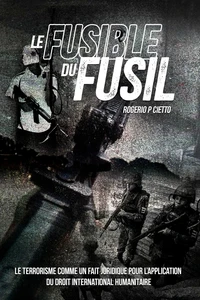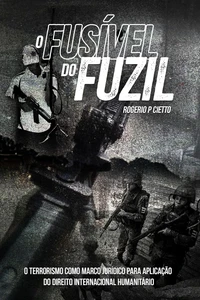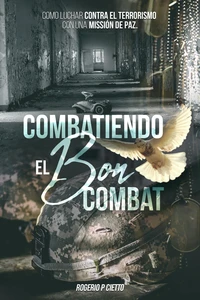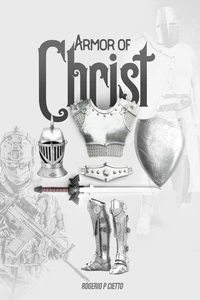The Fuse of the Fusil – Terrorism as a Legal Fact for the Application of International Humanitarian Law
Par :Formats :
Disponible dans votre compte client Decitre ou Furet du Nord dès validation de votre commande. Le format ePub est :
- Compatible avec une lecture sur My Vivlio (smartphone, tablette, ordinateur)
- Compatible avec une lecture sur liseuses Vivlio
- Pour les liseuses autres que Vivlio, vous devez utiliser le logiciel Adobe Digital Edition. Non compatible avec la lecture sur les liseuses Kindle, Remarkable et Sony
 , qui est-ce ?
, qui est-ce ?Notre partenaire de plateforme de lecture numérique où vous retrouverez l'ensemble de vos ebooks gratuitement
Pour en savoir plus sur nos ebooks, consultez notre aide en ligne ici
- FormatePub
- ISBN978-1-005-17342-5
- EAN9781005173425
- Date de parution06/09/2022
- Protection num.pas de protection
- Infos supplémentairesepub
- ÉditeurC. C. Chamberlane
Résumé
The fuse is a safety device in an electrical circuit, whose function is to interrupt the flow of electrical current in the circuit, when it exceeds the limit allowed by the fuse, thus preventing a short circuit. In the past, it served to protect the electrical part of homes and was replaced by the circuit breaker, which simply turns off when the current is greater than it can handle. Today, fuses are widely used in home appliances.
The fusil is a portable firearm, in which the ammunition is inserted on the back, semi-automatic or automatic, with a long tube with a rifled core (for greater precision) (Decree 10.030, of September 30, 2019, Controlled Products Regulation (R-105), access on August 20, 2020). Unlike a pistol (weapon for personal defense), the rifle has a greater range and is more destructive, being the weapon used by armed forces around the world in international and non-international conflicts and even in situations of repression against criminal groups and terrorists.
Just as the fuse is used to protect the home from excess electrical current, the fusil (the use of armed force) is used to protect a country from excessive political-legal tension. The fuse blows to protect the electronics assembly of a device from a hazardous situation. The fusil enters the scene to protect the set of political, legal and even economic values ??of a society at risk. But it's easy to measure the current in a circuit and design a compatible fuse according to average use.
On the other hand, it is not easy to find a reliable indicator for the use of armed forces in the different political and legal situations of tension in a society. Between lasting peace and genocide there is a cloud of hypotheses of internal tensions, caused by natural and anthropological elements, even the mixture of both. Why is this definition important? Because from it, the applicable legal system will be defined to legitimize the use of force.
Briefly, for situations of institutional normality (including internal disturbances, fighting and preventing crime and political demonstrations) the Human Rights (HR) rules are applicable. For cases of institutional collapse (coups, armed revolutions and civil wars), international humanitarian law (IHL) is the most appropriate.
The fusil is a portable firearm, in which the ammunition is inserted on the back, semi-automatic or automatic, with a long tube with a rifled core (for greater precision) (Decree 10.030, of September 30, 2019, Controlled Products Regulation (R-105), access on August 20, 2020). Unlike a pistol (weapon for personal defense), the rifle has a greater range and is more destructive, being the weapon used by armed forces around the world in international and non-international conflicts and even in situations of repression against criminal groups and terrorists.
Just as the fuse is used to protect the home from excess electrical current, the fusil (the use of armed force) is used to protect a country from excessive political-legal tension. The fuse blows to protect the electronics assembly of a device from a hazardous situation. The fusil enters the scene to protect the set of political, legal and even economic values ??of a society at risk. But it's easy to measure the current in a circuit and design a compatible fuse according to average use.
On the other hand, it is not easy to find a reliable indicator for the use of armed forces in the different political and legal situations of tension in a society. Between lasting peace and genocide there is a cloud of hypotheses of internal tensions, caused by natural and anthropological elements, even the mixture of both. Why is this definition important? Because from it, the applicable legal system will be defined to legitimize the use of force.
Briefly, for situations of institutional normality (including internal disturbances, fighting and preventing crime and political demonstrations) the Human Rights (HR) rules are applicable. For cases of institutional collapse (coups, armed revolutions and civil wars), international humanitarian law (IHL) is the most appropriate.
The fuse is a safety device in an electrical circuit, whose function is to interrupt the flow of electrical current in the circuit, when it exceeds the limit allowed by the fuse, thus preventing a short circuit. In the past, it served to protect the electrical part of homes and was replaced by the circuit breaker, which simply turns off when the current is greater than it can handle. Today, fuses are widely used in home appliances.
The fusil is a portable firearm, in which the ammunition is inserted on the back, semi-automatic or automatic, with a long tube with a rifled core (for greater precision) (Decree 10.030, of September 30, 2019, Controlled Products Regulation (R-105), access on August 20, 2020). Unlike a pistol (weapon for personal defense), the rifle has a greater range and is more destructive, being the weapon used by armed forces around the world in international and non-international conflicts and even in situations of repression against criminal groups and terrorists.
Just as the fuse is used to protect the home from excess electrical current, the fusil (the use of armed force) is used to protect a country from excessive political-legal tension. The fuse blows to protect the electronics assembly of a device from a hazardous situation. The fusil enters the scene to protect the set of political, legal and even economic values ??of a society at risk. But it's easy to measure the current in a circuit and design a compatible fuse according to average use.
On the other hand, it is not easy to find a reliable indicator for the use of armed forces in the different political and legal situations of tension in a society. Between lasting peace and genocide there is a cloud of hypotheses of internal tensions, caused by natural and anthropological elements, even the mixture of both. Why is this definition important? Because from it, the applicable legal system will be defined to legitimize the use of force.
Briefly, for situations of institutional normality (including internal disturbances, fighting and preventing crime and political demonstrations) the Human Rights (HR) rules are applicable. For cases of institutional collapse (coups, armed revolutions and civil wars), international humanitarian law (IHL) is the most appropriate.
The fusil is a portable firearm, in which the ammunition is inserted on the back, semi-automatic or automatic, with a long tube with a rifled core (for greater precision) (Decree 10.030, of September 30, 2019, Controlled Products Regulation (R-105), access on August 20, 2020). Unlike a pistol (weapon for personal defense), the rifle has a greater range and is more destructive, being the weapon used by armed forces around the world in international and non-international conflicts and even in situations of repression against criminal groups and terrorists.
Just as the fuse is used to protect the home from excess electrical current, the fusil (the use of armed force) is used to protect a country from excessive political-legal tension. The fuse blows to protect the electronics assembly of a device from a hazardous situation. The fusil enters the scene to protect the set of political, legal and even economic values ??of a society at risk. But it's easy to measure the current in a circuit and design a compatible fuse according to average use.
On the other hand, it is not easy to find a reliable indicator for the use of armed forces in the different political and legal situations of tension in a society. Between lasting peace and genocide there is a cloud of hypotheses of internal tensions, caused by natural and anthropological elements, even the mixture of both. Why is this definition important? Because from it, the applicable legal system will be defined to legitimize the use of force.
Briefly, for situations of institutional normality (including internal disturbances, fighting and preventing crime and political demonstrations) the Human Rights (HR) rules are applicable. For cases of institutional collapse (coups, armed revolutions and civil wars), international humanitarian law (IHL) is the most appropriate.













